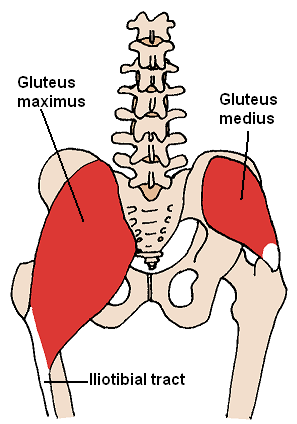Many yoga students, including me, struggle with standing balancing poses like tree pose, or vrksasana.
In this post, we’ll look at the primary muscle that stabilizes your pelvis when you’re standing on one leg, which is called the gluteus medius. Understanding how your gluteus medius works, how to activate it, and how to develop your awareness of it may help you balance in those poses.
How balance works
For you to be in balance, your center of gravity has to be on top of your base of support. In standing, your center of gravity is located in your pelvis, and your base of support, of course, is your feet.
But when you balance, you don’t hold yourself rigidly in place. You’re not a stone statue; you’re a living, breathing human being. Your body is constantly in motion, even when you’re standing “still,” so your center of gravity shifts continuously. You move a little away from the center and then come back.
Of course, the smaller those movements away from the center are, the easier it is to regain it.
There are three main strategies we use to maintain balance on one leg.
The first, and most efficient, is a “foot” strategy. Making small weight shifts with your foot allows you to regain balance with very little energy.
If that fails, the next strategy is a “pelvis” strategy, i.e. shifting the pelvis to keep it on top of the foot. Because the pelvis is heavy, this takes more energy and it’s easy to shift too far off the center. When that happens, you fall back on the strategy of last resort, which is to put both feet down.
So clearly, pelvic stability is important for balance.
It’s relatively easy to balance when you’re standing on two legs because you’ve got support underneath both sides of your pelvis. But what happens when you pick up one foot?
Now you no longer have support under one side of the pelvis. Gravity will pull that side downward, which can shift the pelvis off your base of support.
The gluteus medius
The primary muscle that stabilizes the pelvis when you’re standing on one leg is the gluteus medius, located on the side of the hip. It’s a fan-shaped muscle, with a broad origin on the upper rim of the pelvis, or the crest of the ilium. From there its fibers converge to attach to the greater trochanter, the knob of bone on the outside of the thigh bone.

It’s generally described as an abductor of the hip joint, meaning that it raises the thigh out to the side. But functionally, its real job is to keep the pelvis level when you’re standing on one leg.
As the unsupported side of the pelvis dips, the standing leg hip joint moves into relative adduction—the opposite of abduction. That may be hard to picture, since it’s the pelvis that’s moving rather than the thigh. But as the center of the pelvis moves toward the standing thigh, the relative movement is the same as if the standing thigh were moving toward the midline, which is the movement of hip adduction.
To prevent that, the gluteus medius on the standing leg side contracts, pulling the upper rim of the pelvis downward toward the greater trochanter, which lifts the unsupported side of the pelvis.
You can feel this for yourself in standing. Place your hand on the side of your pelvis just below the upper rim of your pelvis and lift your other foot. You should feel the gluteus medius on the standing leg side contracting reflexively.
This stabilization is especially important in walking. Every time you pick up your foot to take a step, the gluteus medius on the standing leg side kicks in—or it should—to keep your pelvis stable.
The same thing should happen reflexively when you stand on one leg. But if your pelvis shifts excessively, it may be helpful to activate the gluteus medius to bring awareness to its function.
Activating your gluteus medius
To do that, place a block close to a wall and stand on the block with one foot. You can place the hand on that side on the wall to help your balance. Then lift and lower the unsupported foot by lifting and lowering that side of the pelvis. Keep your standing knee. straight You’ll notice that when you lower your foot, your pelvis swings toward the wall. Raising your foot will bring the standing leg side of your pelvis more toward the center.
Pay attention to the sensation of the contraction of the gluteus medius on the outside of the standing leg hip. Once you have a clear sense of that action, step off the block and try coming into tree pose. Find the same feeling of engaging the outer hip on the standing leg side to bring the pelvis on top of that leg. There will be some weight shift toward that side to keep your weight centered on top of the foot, but keeping the hip from swinging too far out to the side should help you stay more stable.
A useful cue is to press your bent knee foot into your standing thigh, while pressing the standing leg hip toward the midline. That action of drawing in toward the midline may help give you a clearer sense of length and lift through the center of your body, so that you can stand tall with your pelvis on top of your standing leg, solid and secure in your balance without gripping or holding your breath.
Very helpful and clearly written. Saw your video on wheel prep thru Jenni Rawlings and really appreciated the incremental Feldenkreiss approach, along with the anatomical terminology.
Thanks! Glad you liked it